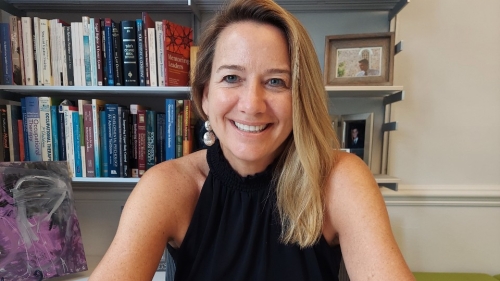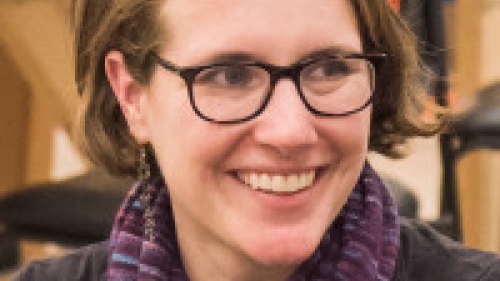The previous article in this series explored research and real-world impact in NYU Steinhardt’s Department of Teaching and Learning along the vein of understanding and facilitating the journey of students with disabilities from high school to adulthood.
Also working in a similar space of re-envisioning career paths for children with disabilities is Kristie Patten, vice dean of academic affairs, associate professor of occupational therapy, and PI of NYU Steinhardt's ASD Nest Program, an inclusive program for children and adolescents on the autism spectrum in the New York City Department of Education.
Patten is co-PI of an NSF grant that leverages STEM interests of middle school students with autism to develop social competence and potential career pathways. “IDEAS: Inventing, Designing, and Engineering on the Autism Spectrum” is a three-year project that brings together researchers, maker program developers from New York Hall of Science, educators, and students on the autism spectrum to create a program that prepares middle-school students with and without autism for careers as inventors, designers, and engineers.

Kristie Patten
From 2016 through 2019, IDEAS reached 140 students (57 autistic and 83 neurotypical), enabling them to build engineering and design skills as they socialized with their peers. In addition, the project gave 10 teachers the opportunity to learn how to facilitate maker activities, a skill they can continue to use to run the IDEAS program, and which can also enhance their classroom teaching.
“IDEAS is about shifting the model and creating a strength-based, inclusive club,” says Patten. “Research has shown that the way we tend to view autism in the community is by placing the burden on the autistic individual to adapt to ‘regular’ interactions. Through this NSF grant, we have found that these kinds of inclusive clubs that allow students to explore their own interests, the social interaction autistic kids are capable of is incredible – with other kids with autism and those without. If models like this work, we can create a new perspective that social interaction issues aren’t due to faults of autistic kids, but rather a bidirectional mismatch.”
In 2019, Patten was awarded another three-year NSF grant to continue developing abilities and skills for careers in design and engineering for students on the autism spectrum by scaling up making experiences. The project seeks to expand the NSF’s Innovative Technology Experiences for Students and Teachers (ITEST) program to more autism-inclusion middle schools, as well as open it up into autism-inclusion elementary and high schools.

Amy Hurst
Creating Innovative Solutions
Amy Hurst, associate professor of occupational therapy, is the director of the Ability Project, an interdisciplinary research space in which students and faculty from all over NYU collaborate to create inclusive systems, design human-centered projects, and further understand and research in the area of ability.
“Our focus on the intersection of technology and disability means that a lot of different things come out of the Ability Project,” says Hurst. “Our deep ties to engineering and occupational therapy lead us to more solution-focused projects, but many of our outcomes are simply to better understand specific populations’ attitudes towards technologies.”
The Ability Project is incredibly interdisciplinary, having been established through a seed grant in 2013 and a collaboration between NYU Steinhardt’s Occupational Therapy Department, NYU Tandon’s Integrated Digital Media Programs, and NYU Tisch’s Interactive Telecommunication Program. The research that associated faculty and students conduct is practical and community based.
“Our deep ties to engineering and occupational therapy lead us to more solution-focused projects, but many of our outcomes are simply to better understand specific populations’ attitudes towards technologies.”
For example, Ability Project researchers – which include students, Hurst, and Anita Perr, clinical professor of OT – are collaborating with the Intrepid Sea, Air & Space Museum on an accessibility exhibit for museum visitors with disabilities. Funded by a grant from the Institute of Museum and Library Services (IMLS) called “Sensory Tools,” they are working with historic sites and disability advocates to design and develop strategies to increase accessibility for visitors.
“This particular project is not about building accessibility, but rather once you’re at the museum, how do you interact with the content?” says Hurst. “For example, at most history museums you’re not able to physically touch the exhibits, so what kind of tactile interpretation—like mini models or swatches of fabric—can we offer instead?”

Photo courtesy of the Intrepid Sea, Air & Space Museum.
This question has been explored in a special topics course taught by Hurst and Perr for three consecutive years where occupational therapy, engineering, design, and art students have worked with historic sites and disability advocates to build prototypes that address the accessibility gaps in historic sites and museums.
Prototypes developed by the team were on display in the “Making History Accessible” exhibit at the Intrepid Museum in fall 2021, which invited guests to test and evaluate a series of digital and physical experiences that aim to make exhibits at historic sites and house museums more inclusive. In spring and summer 2022, partner sites will be recreating these digital and physical experiences for their own guests.
Related to this work, researchers at the Ability Project have also worked to create sensory maps of museums and other spaces to help improve people’s experiences. Steinhardt occupational therapy students worked over the summer on these maps to assist people with specific disabilities, but the innovation can have benefits for all visitors.
“The original aim was to help people with heightened sensing to avoid overstimulating spaces, such as a particularly noisy museum exhibit or a game with flashing lights,” says Hurst. “But these kinds of maps can offer helpful information for many different kinds of visitors: Think of a farm offering a map of when certain fields will have the most pollen for people with allergies, or a schedule of when cleaning crews will be sanitizing certain areas for people whose migraines are triggered by strong smells.”
Projects like this highlight an overall attitude among Steinhardt researchers and students that improving services for people with disabilities can help improve quality of life for all.
